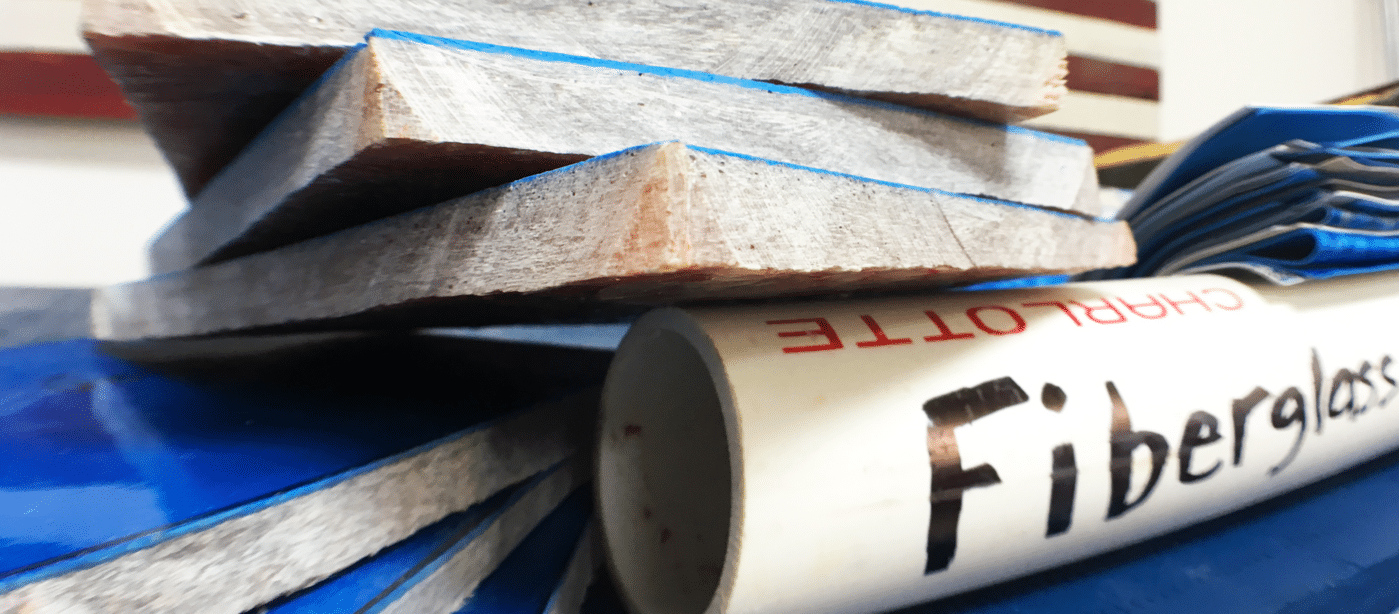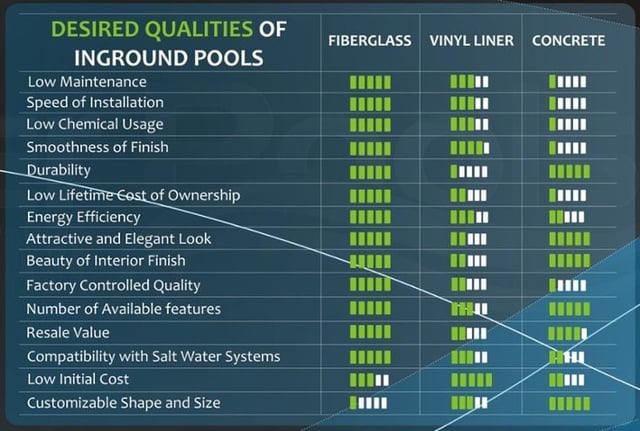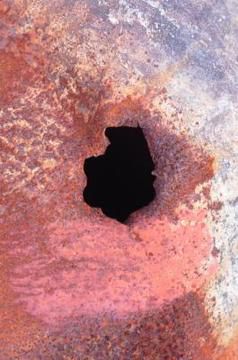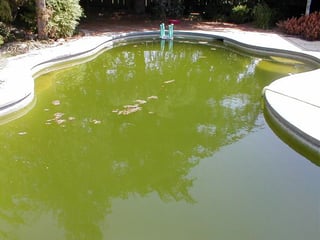
Vinyl Liner Pools vs. Fiberglass Pools: An Honest Comparison
Fiberglass Pool Information | Fiberglass vs Concrete vs Vinyl Liner | Vinyl Liner Pool Information
Considering a fiberglass or vinyl liner pool? We’re here to help. While we manufacture fiberglass pools, our main goal is happy pool owners. So, we try to provide information on all types of pools.
We want you to be able to choose the pool that’s best for you. We will look at the following to help you determine whether a fiberglass or vinyl liner pool best fit your needs:
- Customization
- Installation time
- Cost (initial and lifetime)
- Interior surface texture
- Durability
- Hands-on maintenance
- Algae
- Chemical usage
- Energy usage

Vinyl liner vs. fiberglass pools
Vinyl liner pools typically cost less, often about $10,000+ less than fiberglass pools. However, they require the liner to be replaced every 5–9 years and may not have the same aesthetic appeal. In contrast, fiberglass pools are much more durable and require less maintenance.
Customization
Fiberglass
Fiberglass pools typically run up to 16 feet wide, 40 feet long, and 8.5 feet deep. While you can choose a wide variety of designs, you are limited to the predesigned molds.
Beyond size limitations, you can customize your pool with water features, tiles, therapy jets, and colorful lights to match any aesthetic you desire.
Although fiberglass pools are not customizable in terms of shape, many models include popular features such as tanning ledges, benches, and seats at no extra cost.
Vinyl Liner
Most vinyl liner pools are rectangular, but you can definitely customize the shape, size, and depth of the pool. Specialty shapes and custom features will add to the cost, and may push the cost to rival or exceed that of fiberglass pools.
Conclusion
Fiberglass pools can include popular features and easily have accessories added, but the options for overall shape are limited. Vinyl liner pools can be customized to almost any size as long as the liner can be cut to the correct shape. Winner: Vinyl Liner
Installation Time
Fiberglass
We manufacture the fiberglass pool shell off-site and prepare it to be shipped to your location. Many installers state these types of pools offer the fastest installation process. In fact, it is not uncommon to see the pool shell, installed and filled with water, within one week! However, the patio and decking will require an additional several weeks to complete.
From beginning to end, the entire process typically takes 4–6 weeks as reported by independent installers.
What’s the fastest installation we’ve seen? Try 8 hrs, 15 mins. This particular job was a timed challenge performed by industry expert Jason Hughes, several years ago. You can watch him achieve this feat here.
Vinyl Liner
The full construction process takes place in your backyard. Your vinyl liner pool may be ready to use in 6–8 weeks.
Conclusion
Both pool types have short installation times compared to concrete pools (3-6 months). However, fiberglass pools offer a potentially faster process. In many cases it can be a few weeks shorter than vinyl liner, and bonus: the shorter timeline means your backyard gets put back together that much faster. Winner: Usually Fiberglass
Cost (initial and lifetime)
Fiberglass
Fiberglass pools can have starting costs between $55,000-100,000, depending on the pool size and the overall scope of the project.
Most turn-key fiberglass pool projects end up costing between $85,000–$200,000. As usual, you’ll pay more for extensive landscaping, accessories, and water features.
Long-term, your only serious maintenance expenses will be in chemicals and electricity. You’ll likely spend around $1,500 over a year for a cleaning service, and less if you perform the upkeep yourself.
Vinyl Liner
Most vinyl liner pools cost at least $10,000 less than similar fiberglass or concrete pools.
Vinyl liner packages from most pool builders typically range $50,000–$70,000, and many projects can easily approach $90,000+ depending on the scope of the project.
Vinyl liner pools often require less maintenance compared to concrete pools. The material doesn't provide algae a place to hold on to, unlike the typical plaster surface on concrete pools.
Vinyl liners generally need to be replaced every 5–9 years, with replacement costs typically ranging from $4,000 to $6,000, including both labor and materials.
How this adds up: the low initial cost of the pool could be offset within the first ten years after construction, and over the entire lifetime of the pool, it may cost thousands more than a fiberglass pool.
On top of the initial and lifetime costs, you’ll need to read your whole liner manufacturer’s warranty. The warranty often includes fine print that could make things challenging or costly:
- The warranty may only cover the seams of the liner, where the sections of material are fused together.
- The warranty may not cover any labor, water, or other expenses.
- The warranty is likely prorated—some credit toward a new liner during the first 2-3 years, but very little after that.
Conclusion
Vinyl liner pools are cheaper upfront and may be the better option if you’re on a budget or fancy a major DIY* project. Fiberglass is a bit more expensive initially but costs less in the long run. Winner: Fiberglass
*River Pools do not advise anyone to take on any inground pool as a DIY project. Always seek the services of a professional pool builder.
Interior surface texture
Fiberglass
The interior surface of a fiberglass pool is created with a resin material referred to as gelcoat. It’s smooth to the touch.
Steps or tanning ledges are designed to have a slip-resistant texture that’s pleasant to walk on.
Vinyl Liner
The vinyl liner is smooth, other than the welded seam where one piece meets another. Just be sure to prepare to replace the liner at about the 7 year mark. You may not need to replace it at that time, but at least you won’t be caught off guard if it’s needed.
Conclusion
Both surfaces are super smooth and very pleasant to walk on as long as they’re well-maintained. Winner: Tie
Durability
Fiberglass
If the gelcoat is applied correctly, and well-maintained once installed in your backyard, you’ll never need to refinish it.
The layers of materials in a fiberglass pool shell provide it with a lot of strength and flexibility. (Learn more about how fiberglass pools are made here.)
Vinyl Liner
Vinyl liners for inground pools are usually 20 - 30 mils thick—less than a millimeter. Dog claws or a broken branch from a nearby tree can tear that pretty easily.
Weird fact: bugs such as ants and termites can actually chew through a vinyl liner.
- Hire an exterminator to treat the ground when building a new pool.
- Verify that your liner warranty covers insects.
- Try not to think too hard about creepy little bug mouths.
The liner doesn’t last long overall. You need to replace it every 5–9 years. Even without any major punctures, regular wear-and-tear takes a toll.
Underneath that liner, your wall panels lead a dangerous life. Over time, metal wall panels corrode (and even disintegrate), and while polymer wall panels last longer, they can become brittle. Be sure to ask your installer about the latest in vinyl liner wall material options.

Corrosion led to rust on the wall of this vinyl liner pool.
Conclusion
The pieces that put together a vinyl liner pool are relatively fragile and need a lot of tlc. In contrast, the fiberglass pool shell and gelcoat are solid and built to last. Winner: Fiberglass
Hands-on maintenance
Fiberglass
The gelcoat surface is inert, meaning it doesn’t affect the water's pH. You still need to test your water chemistry often. But making adjustments as needed to maintain water balance and sanitizer levels should be fairly easy.
Vinyl Liner
We think you’d find that maintaining water balance and sanitizer levels of a vinyl liner pool to be much like a fiberglass pool, fairly easy.
BUT…Because the vinyl material is so pliable, you’ll need to be more diligent with care to help prevent punctures and tears.
In addition, many vinyl liner owners report the appearance of wrinkles in the vinyl liner that develop over time. They won’t hurt anything, but if you choose to smooth them out, that takes significant time and effort.
Divots and dents are usually cosmetic issues as well, but a bump due to a rock or pebble could lead to a tear in the liner. For these issues, you have to drain the pool and remove the liner for repairs.
Conclusion
Regardless of pool type, you need to test the water chemistry regularly. We advise testing daily, but at least weekly. Many pool owners report that fiberglass pools are the easiest type of pool to maintain. Winner: Fiberglass
Algae
Fiberglass
The gelcoat of a fiberglass pool is smooth and algae-resistant.
Vinyl Liner
The surface of a vinyl liner pool is also relatively algae-resistant.
However, algae can grow in submerged areas that don’t circulate water, like the seams and around the pool steps.
Conclusion
Both surfaces lack the algae-friendly pores of concrete pools. However, the vinyl liner seams can present a problem. Winner (with a slight edge): Fiberglass
Chemicals and electrical energy
Fiberglass
Fiberglass pools use fewer chemicals because, again, little to no algae. Depending on the system, you can also run the pump and filter in shorter cycles or at lower speeds. Hurray for energy savings!
Vinyl Liner
Vinyl liner pools also require less time and money to keep the chemistry in balance. A vinyl liner pool’s pump/filter system requires less energy than a concrete pool. It’s actually closer to a fiberglass pool’s energy bill.
Conclusion
Both types have lower energy needs than a concrete pool. Still, be sure to regularly measure and maintain your pool’s alkalinity, pH, calcium hardness, and chlorine levels according to the recommended levels provided by the manufacturer, and become familiar with water balance to preserve the finish of your pool.
Although we’re partial to the pools we manufacture, the truth is, that the overall winner in this category is too close to call. Winner: Tie
| Vinyl Liner Pools | Fiberglass Pools | |
| Customization | Shape, size, and depth can be customized | Limited to predesigned molds |
| Installation Time | 6-8 weeks | 4-6 weeks |
| Starting Cost | $45,000 and up | $55,000 and up |
| Interior Surface Texture | Very Smooth but has seams | Very Smooth |
| Durability | Liners can tear easily | Surface and shell are very durable |
| Sanitation System Options | Compatible with most sanitation systems. | Compatible with all sanitation systems |
| Maintenance | Need to test chemistry at least weekly and replace liner around 7 years | Need to test chemistry at least weekly |
| Algae | Algae resistant, but it can still gather around seams and other poorly circulated areas | Fiberglass is non porous and agae resistant |
Which should I choose?
Only you know your priorities for your new pool. We can only provide different aspects to consider as you determine the best fit for you and your family. Maybe the pool needs to fit your specific aesthetic regardless of cost? Or maybe you’d prefer low costs over customization?
Vinyl liner pools are typically a good fit for those who:
- Have a budget of around $55,000
- Want to make the pool a DIY project
- Will only live in the home for two or three years (and can avoid the first liner replacement)
- Want the biggest pool for the cheapest price
Fiberglass pools are typically a good fit for those who:
- Have a budget of $55,000 or more
- Can find a fiberglass swimming pool design that meets your needs
- Want the least maintenance possible
- Want a pool with low long-term costs
- Want a quick installation
Unlike vinyl liner pools, fiberglass pools can last a long time, and be customized with cool add-ons like water features and LED lights.
At River Pools, we manufacture both freeform and linear fiberglass pools that are available for purchase and installation through independent installers around the country. If you think a fiberglass pool might be the right choice for you, we're here to answer any questions you have.
If you're still on the fence about which type of pool may be best for you, click the button below to take the quiz. A comprehensive recommendation will be sent directly to your inbox.
Up Next:
What Type of Inground Pool Is Best for Me?
How Long Do Vinyl Liner Pools Last?
What Is the Life Expectancy of a Fiberglass Pool?
Editor's note: This article was originally written by Holly Jender and was updated on August 19, 2024, with current information. River Pools is a brand of
inground fiberglass pools produced in a manufacturing facility in Fortville, IN. While our expertise is in manufacturing fiberglass pools, we have access to a network of installers with expertise in project design, installation, and pool service. We often tap into this knowledge base and share information freely with homeowners, just like you, who are considering installing a backyard swimming pool.






